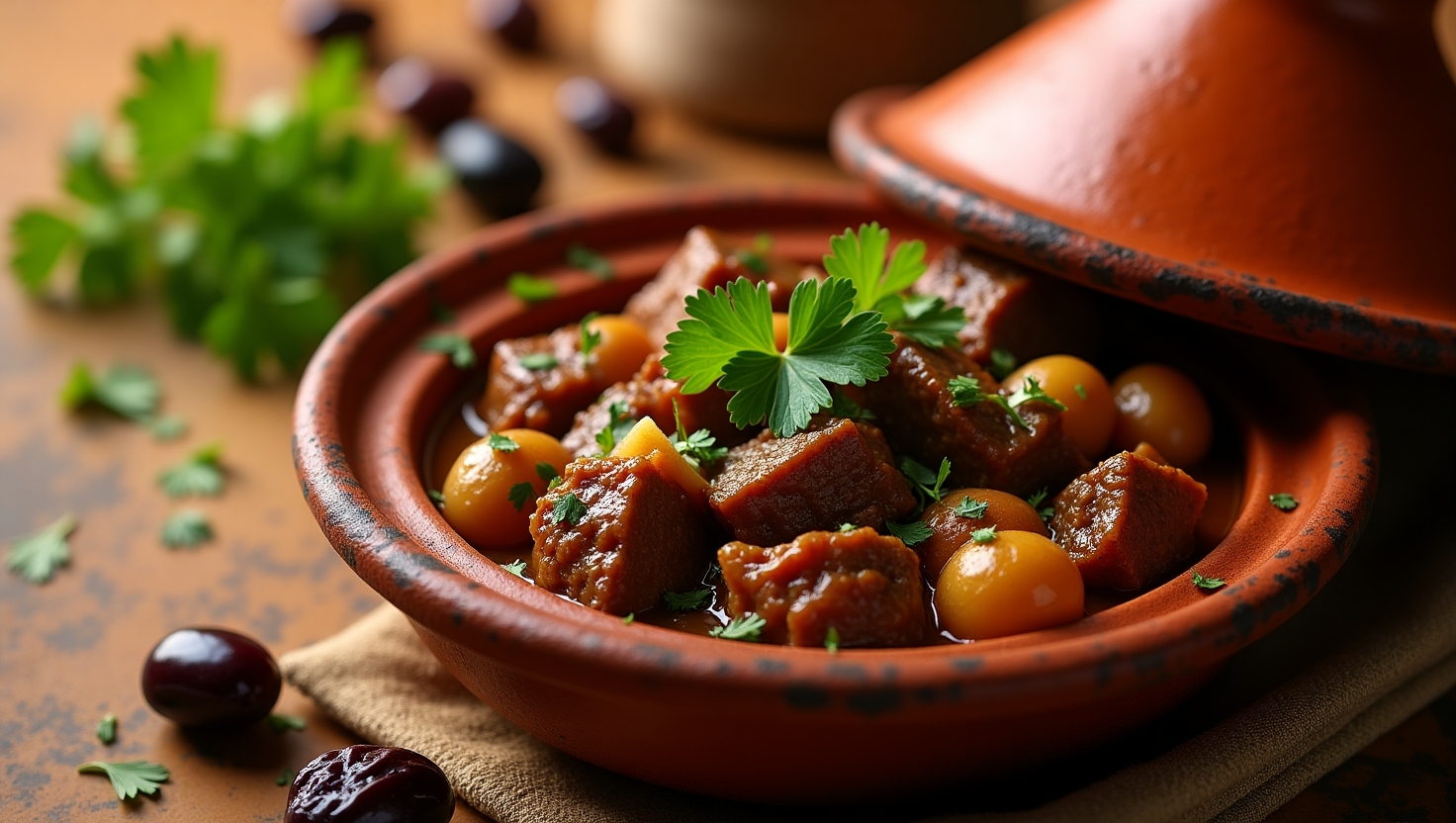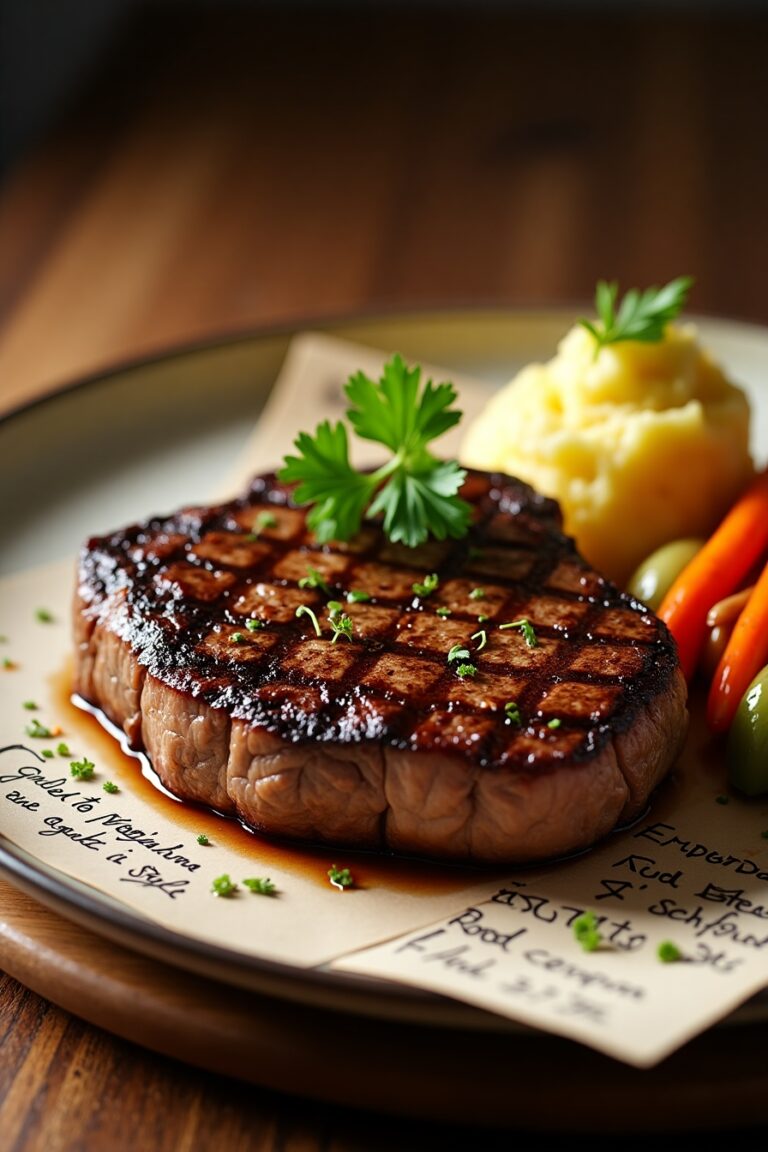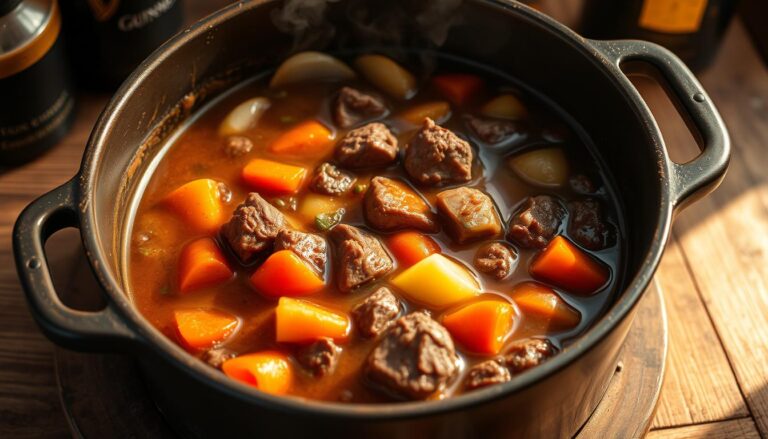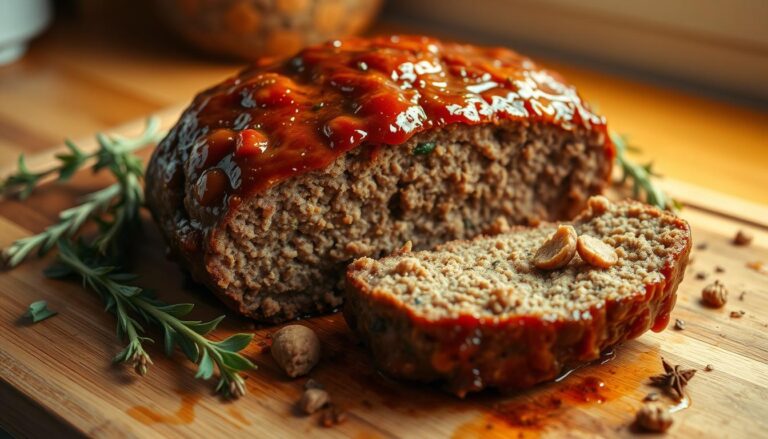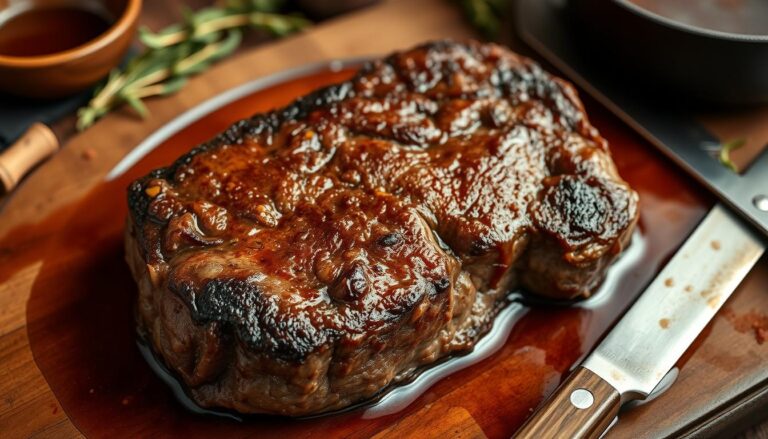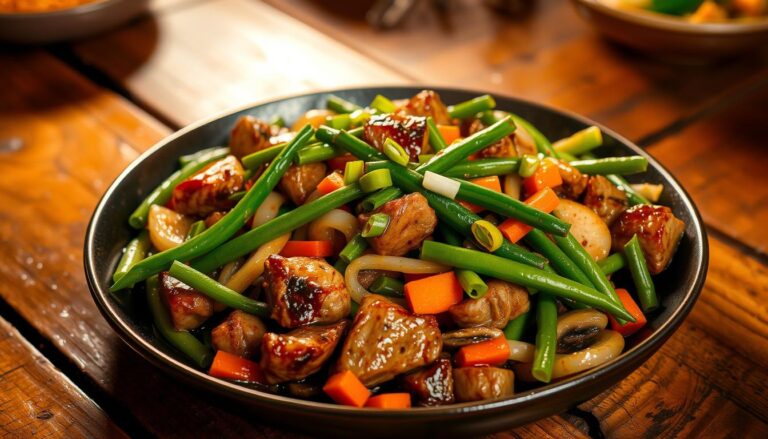Make Beef Tagine Moroccan Recipe

The first time I tasted a Beef Tagine Moroccan Recipe, my world changed. I was in a small restaurant in Marrakech. The smells of slow-cooked beef, spices, and herbs took me to the heart of Moroccan cuisine. It’s more than a meal; it’s a journey through generations.
Moroccan cuisine is a celebration of culture, family, and connection. The Beef Tagine Recipe captures this spirit. It combines tender meat, vibrant veggies, and a mix of spices that tell a story of North African cooking.
If you love cooking or want to try traditional recipes, this dish is for you. It offers an authentic taste experience. It brings the warmth of Moroccan kitchens to your table.
Key Takeaways
- Discover the rich cultural heritage of Moroccan cooking
- Learn an authentic Beef Tagine recipe from scratch
- Explore traditional North African flavor combinations
- Master slow-cooking techniques for tender, flavorful meat
- Create a restaurant-quality meal in your own kitchen
What is Beef Tagine?
Beef tagine is a journey into North African flavors. It combines rich traditions with special cooking techniques. This iconic stew turns simple ingredients into a taste and texture masterpiece, all thanks to the unique tagine cooking vessel.
A beef tagine is more than a meal; it’s a cultural experience. It captures the essence of Moroccan cuisine. The cone-shaped tagine cooking vessel is key to its slow-cooked perfection.
Overview of Tagine Cooking
The tagine cooking method uses a special ceramic pot. It has a tall, conical lid that circulates steam and keeps moisture in. This design makes the meat tender, intensifies flavors, and keeps ingredients distinct.
Origins of Beef Tagine
Beef tagine comes from North Africa, especially Morocco. It reflects centuries of culinary evolution. Berber tribes created this method to make flavorful meals with limited resources.
“A tagine is not just a dish, it’s a window into Moroccan culture and tradition.” – Moroccan Culinary Expert
Flavor Profile
The magic of beef tagine is in its complex flavors. North African flavors blend through warming spices like cumin, coriander, cinnamon, and paprika. Each bite balances savory meat with aromatic seasonings.
- Spices: Create depth and warmth
- Meat: Typically slow-cooked until meltingly tender
- Vegetables: Add texture and additional layers of flavor
Key Ingredients for Beef Tagine
To make a real beef tagine, you need the right ingredients. They turn this dish into a true culinary gem. The mix of spices, herbs, top-notch meat, and fresh veggies will make your Moroccan dish unforgettable.
Essential Spices that Define Flavor
Spices and herbs are the soul of Moroccan cooking. Your beef tagine will burst with flavor from these special seasonings:
- Cumin: Gives a warm, earthy taste
- Coriander: Adds a bright, citrusy flavor
- Cinnamon: Adds a hint of sweetness
- Saffron: Adds a luxurious golden color and taste
- Paprika: Adds mild heat and color
Selecting the Perfect Beef Cut
Choosing the right meat is key for tender beef tagine. Look for cuts that get tender with slow cooking:
- Chuck roast
- Beef brisket
- Short ribs
These cuts are full of fat and connective tissue. They become incredibly tender after slow cooking.
Fresh Vegetables to Complement Your Dish
Vegetables add flavor and nutrition to your beef tagine. Traditional choices include:
- Carrots
- Onions
- Preserved lemons
- Green olives
- Bell peppers
Each veggie brings its own taste and texture. Together, they make a meal that truly captures Moroccan cuisine’s spirit.
Equipment You’ll Need
To make a real beef tagine, you need special cooking tools. These tools turn your kitchen into a Moroccan cooking spot. The right tagine and utensils make slow cooking fun and easy.
Choosing the right cooking gear is key for a tasty beef tagine. The cooking pot you pick can really change the dish’s taste and feel.
Tagine Pot vs. Dutch Oven
For beef tagine, you have two main cooking pot choices:
- Traditional Ceramic Tagine: Real, cone-shaped pottery that lets steam move around
- Dutch Oven: Good for home cooks who don’t have a traditional tagine
The ceramic tagine gives a true slow cooking feel. A Dutch oven, on the other hand, cooks evenly.
Recommended Utensils
Here are the must-have tools for making beef tagine:
- Sharp chef’s knife
- Cutting board
- Wooden spoon
- Measuring spoons
- Heavy-bottomed cooking pot
Safety Tips for Cooking
When using a tagine or Dutch oven, remember these safety tips:
- Always use oven mitts when handling hot cookware
- Make sure heat spreads evenly
- Avoid big temperature changes
- Check ceramic tagines for cracks before using
“The right tools can transform your cooking from ordinary to extraordinary.” – Moroccan Cooking Proverb
Preparing Your Ingredients
To make a real Beef Tagine Moroccan Recipe, you need to prepare your ingredients well. Each step is important for the rich flavors of this dish. Your careful work will turn simple ingredients into a delicious dish.

Marinating the Beef
Marinating is key for tender, flavorful beef in your Moroccan tagine. Choose a good cut like chuck or shoulder. It takes spices and herbs well. Your marinade should have:
- Olive oil
- Garlic
- Fresh cilantro
- Ginger
- Signature Moroccan spices
“The secret to an exceptional tagine lies in patience and proper marination” – Moroccan Cooking Tradition
Chopping and Slicing Vegetables
When chopping vegetables for your Beef Tagine Moroccan Recipe, be precise. Cut them all the same size for even cooking. Good choices include:
- Sweet onions
- Carrots
- Bell peppers
- Preserved lemons
Preparing Spices and Seasonings
Spices and herbs are the heart of Moroccan cooking. Toast whole spices to get their oils and flavor. Mix a spice blend with:
- Cumin
- Coriander
- Paprika
- Cinnamon
- Turmeric
Pro tip: Grind your spices fresh for the most intense flavor profile in your tagine.
Cooking Techniques for Beef Tagine
Learning to slow cook turns a simple dish into a feast. Beef tagine, a one-pot meal, needs special techniques. These unlock deep flavors that excite your taste buds.
Searing the Beef
The key to a great beef tagine is searing. Choose top-quality beef and dry it before cooking. Heat your pan until it’s scorching hot. Then, add the meat to get a golden crust.
This step is crucial. It adds intense flavor and keeps juices in.
- Use a heavy-bottomed pan for even heat distribution
- Avoid overcrowding the meat while searing
- Cook in batches if necessary
Layering Flavors
Slow cooking blends spices and ingredients perfectly. Start with onions, garlic, and spices. Then, layer your ingredients to enhance the taste.
- Begin with aromatic spices
- Add root vegetables
- Place seared meat on top
- Finish with delicate herbs
Slow-Cooking Process
The magic of slow cooking is in the low and slow method. Keep the temperature around 300°F (150°C). This makes the meat tender and flavorful.
Pro tip: Let your tagine cook without opening the lid. Each time you open it, you lose heat and moisture.
Serving Suggestions
Your Beef Tagine is a journey through Moroccan recipes. It’s more than just food; it’s an experience that shows North African hospitality.

When you serve Beef Tagine, pay attention to the details. The right sides can make your meal unforgettable.
Traditional Accompaniments
Moroccan food is all about sharing and flavors. Here are some classic sides:
- Fluffy couscous
- Warm flatbread
- Herbed rice pilaf
- Moroccan khobz (traditional bread)
Pairing with Sides and Salads
Pair your Beef Tagine with salads to balance its flavors:
| Salad Type | Flavor Profile | Recommended Pairing |
|---|---|---|
| Cucumber Tomato Salad | Fresh and Light | Perfect with Rich Tagine |
| Moroccan Carrot Salad | Spicy and Tangy | Cuts Through Meat’s Richness |
| Roasted Pepper Salad | Smoky and Vibrant | Enhances Tagine Complexity |
Presentation Tips
Make your Beef Tagine look great with these tips:
- Serve in a traditional clay tagine pot
- Garnish with fresh herbs like cilantro or parsley
- Sprinkle toasted almonds for texture
- Use bright, contrasting plates
By using authentic serving methods, your Beef Tagine becomes a true celebration of Moroccan food.
Storing Leftovers
Your delicious one-pot meals like beef stew can be enjoyed beyond the initial serving. Proper storage ensures you can savor your Moroccan beef tagine for several days. This way, you keep its rich flavors and tender meat.
Preserving your beef stew requires careful attention to food safety and storage techniques. Learn how to keep your tagine delectable and safe for future meals.
Safe Storage Practices
- Cool the beef tagine completely before storing
- Use airtight containers with tight-fitting lids
- Divide large portions into smaller containers for quicker cooling
- Store in the refrigerator within two hours of cooking
Reheating Instructions
- Remove tagine from refrigerator 30 minutes before reheating
- Use a stovetop or oven for best results
- Add a small amount of water or broth to prevent drying
- Heat until internal temperature reaches 165°F
How Long Does Beef Tagine Last?
Your one-pot meals like beef tagine can be safely stored in the refrigerator for 3-4 days. For longer preservation, freeze the beef stew for up to 3 months. Always check for any signs of spoilage before consuming leftovers.
Variations of Beef Tagine
Exploring Moroccan cuisine opens a world of creativity. Beef tagine is a great base for trying new ingredients and cooking styles. It shows off the rich flavors of North Africa.
Tagine cooking is all about flexibility. Your kitchen becomes a place for innovation, while keeping true to Moroccan traditions.
Vegetarian Alternatives
Make your beef tagine plant-based with these ideas:
- Replace beef with chickpeas for protein
- Try jackfruit as a meat substitute
- Add roasted eggplant for a meaty taste
- Mix in zucchini, carrots, and bell peppers
Using Different Meats
Try different proteins to bring out North African flavors:
- Lamb – traditional and flavorful
- Chicken – lighter with similar spices
- Goat – a regional meat choice
- Duck – adds a unique depth
Incorporating Seasonal Ingredients
Change your tagine with the seasons. Use root veggies in winter and fresh herbs in summer. Keep the core spice blend that’s key to Moroccan cuisine.
The beauty of tagine lies in its adaptability – a true reflection of North African culinary traditions.
Common Mistakes to Avoid
Making a real Beef Tagine Moroccan Recipe needs attention to detail. Even skilled cooks can make mistakes. Knowing these errors helps you make a dish that truly celebrates Moroccan flavors.
Learning to make a Beef Tagine means avoiding key mistakes. These mistakes can ruin the dish’s taste and texture. Here are the most common errors and how to avoid them:
Overcooking the Beef
Beef that’s tender is what makes a great Beef Tagine. When cooking, remember to cook slowly. If you overcook, the meat becomes tough and dry.
- Cook beef on low heat
- Use tough cuts that benefit from slow cooking
- Check meat tenderness periodically
Skipping the Marinade
The marinade is key for adding depth to your Beef Tagine. Spices and herbs are essential for rich, complex flavors that Moroccan cooking is known for.
| Marinade Component | Purpose |
|---|---|
| Olive Oil | Helps distribute spices |
| Garlic | Adds aromatic depth |
| Cumin | Provides earthy undertones |
Ignoring Spice Balance
Moroccan cooking is all about the right mix of spices. Balanced spices make a good Beef Tagine great. Use fresh, quality spices and measure them right for authentic flavors.
- Toast whole spices before grinding
- Use fresh spices within 6 months
- Taste and adjust seasoning gradually
By avoiding these mistakes, your Beef Tagine will take you straight to Morocco’s lively markets.
Final Thoughts on Beef Tagine
Exploring traditional recipes like Beef Tagine opens a delicious window into North African flavors. It transforms your home cooking experience. This Moroccan culinary treasure is more than just a meal. It’s a cultural journey through spices, techniques, and generations of rich cooking traditions.
Preparing Beef Tagine challenges home cooks to step outside their comfort zone. It invites them to embrace a unique cooking method. The slow-cooking process allows complex spices to meld perfectly. This creates a deeply satisfying dish that reflects centuries of Moroccan culinary expertise.
Your kitchen will fill with aromatic scents. These scents transport you directly to the vibrant markets of Marrakech.
Why You Should Try This Recipe
Diving into North African flavors is an exciting opportunity to expand your culinary skills. Beef Tagine offers a perfect balance of tender meat, rich spices, and hearty vegetables. It appeals to adventurous food lovers.
Whether you’re an experienced cook or a curious beginner, this recipe promises a rewarding and delicious experience. It connects you with a timeless cooking tradition.
Encouragement for Experimentation
Don’t hesitate to make this recipe your own. While respecting traditional techniques, feel free to adjust spices or ingredients to suit your taste. Each variation tells a unique story and contributes to the ongoing evolution of this beloved Moroccan dish.
Invitation to Share Your Experience
We would love to hear about your Beef Tagine adventure. Share your cooking stories, ingredient modifications, and flavor discoveries with fellow food enthusiasts. Your personal touch keeps these traditional recipes alive and inspiring for home cooks everywhere.

